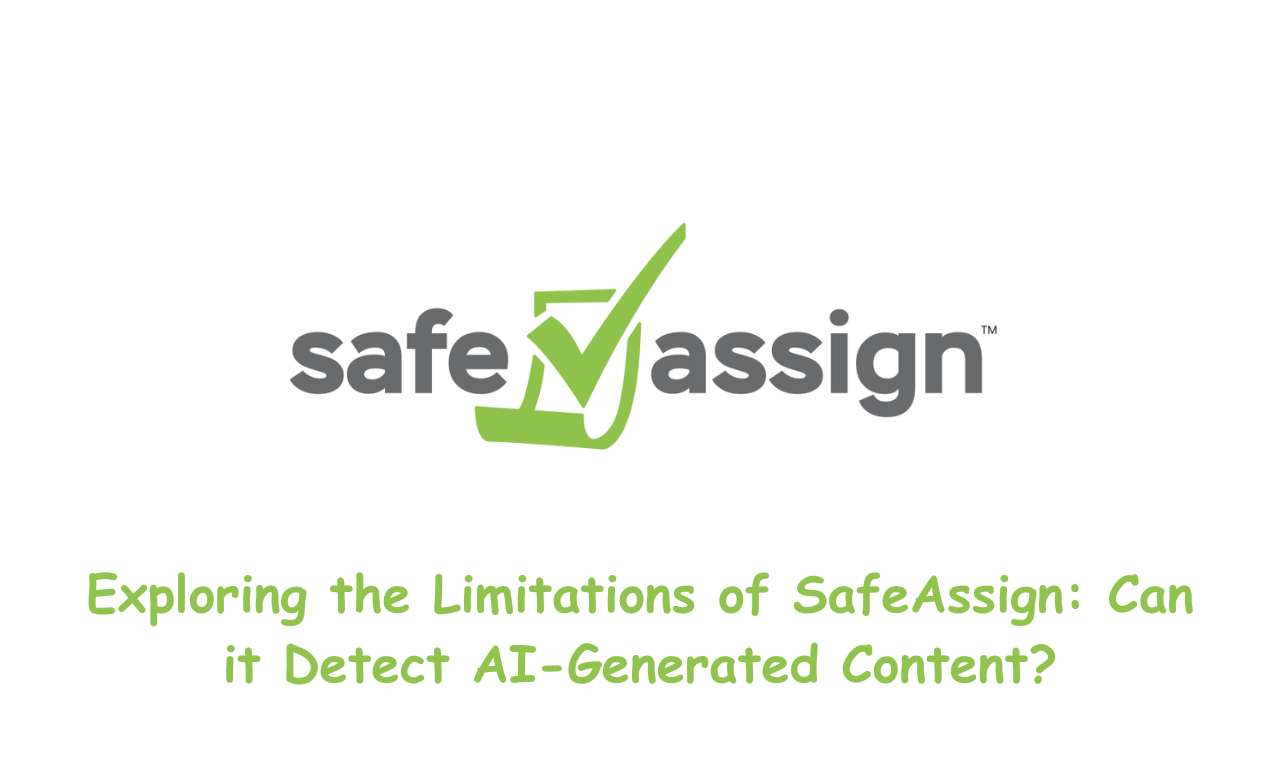Introduction
In an era dominated by technological advancements, the rise of AI-generated content has presented a unique challenge for academic institutions and plagiarism detection tools. This blog aims to delve into the capabilities and limitations of SafeAssign, a widely used plagiarism detection software, in identifying content created by artificial intelligence.
Understanding SafeAssign
SafeAssign is a powerful tool employed by educators and institutions to combat plagiarism. It employs a sophisticated algorithm to compare submitted documents against a vast database of academic content, as well as publicly available material on the internet. Through this process, SafeAssign identifies instances of potential plagiarism by highlighting similarities between the submitted work and existing sources.
The Rise of AI-Generated Content
AI-generated content refers to text, images, or videos created with the assistance of artificial intelligence algorithms. This technology has made significant strides, giving rise to applications like chatbots, automated content creation, and even deepfakes. The proliferation of AI generated content has raised concerns regarding its integration into academic environments.
Limitations of SafeAssign in Detecting AI-Generated Content
- Lack of training data on AI-generated content One of the primary challenges SafeAssign faces is the scarcity of training data specifically tailored to AI-generated content. Since this technology is relatively new, there is a limited corpus of data available for SafeAssign to draw upon when identifying AI-generated work.
- Unique writing style and coherence of AI-generated content AI-generated content often exhibits characteristics that differ from human-authored work. These include a lack of individuality, an absence of personal experiences, and a uniform writing style. SafeAssign may struggle to differentiate between these distinct styles, potentially leading to false negatives or positives.
- Analysis of SafeAssign’s algorithms and their limitations While SafeAssign excels at identifying conventional plagiarism, its effectiveness diminishes when confronted with AI-generated content. The algorithms may struggle to discern the nuances of AI-generated text, which can result in incomplete or inaccurate plagiarism reports.
Case Studies: SafeAssign’s Performance on AI-Generated Content
Research findings indicate that SafeAssign, while proficient in detecting traditional forms of plagiarism, encounters difficulties when faced with AI-generated content. Case studies have revealed instances where SafeAssign failed to identify content generated by sophisticated AI algorithms.
Addressing the Limitations
To enhance SafeAssign’s performance in detecting AI-generated content, several strategies can be employed:
- Dedicated AI-Generated Content Database: Establishing a specialized database containing examples of AI-generated content can provide SafeAssign with the necessary training data to improve its accuracy.
- Algorithm Refinement: Constant refinement of SafeAssign’s algorithms is crucial. This includes integrating machine learning techniques that adapt to evolving forms of AI-generated content.
Future of AI-Generated Content Detection
As AI technology continues to advance, so too must plagiarism detection tools. The future landscape of AI-generated content detection may involve the integration of cutting-edge techniques, such as natural language processing, to better distinguish between human and AI-generated work.
The Challenge of AI-Generated Content
As AI-generated content becomes increasingly sophisticated, traditional plagiarism detection tools like SafeAssign face a formidable challenge. This technology has evolved beyond simple text generation, now capable of emulating human-like writing styles and producing coherent, contextually appropriate content. In some cases, AI-generated essays, articles, and reports can be indistinguishable from those written by humans.
Unique Characteristics of AI-Generated Content
AI-generated content exhibits distinct features that pose a challenge to tools like SafeAssign. Unlike human authors, AI lacks personal experiences, emotions, or subjective perspectives. This often results in content that appears uniform, devoid of individuality, and somewhat detached from the typical nuances of human expression. Consequently, SafeAssign’s algorithms, designed to identify patterns and similarities, may falter in distinguishing between human and AI-generated work.
Case Studies: SafeAssign vs. AI-Generated Content
Several case studies have shed light on SafeAssign’s performance in the face of AI-generated content. In controlled experiments, researchers submitted both human-written and AI-generated papers to SafeAssign for analysis. While the tool excelled at flagging instances of conventional plagiarism, it faced challenges when assessing AI-generated submissions. In some cases, SafeAssign failed to detect AI-generated content entirely, potentially undermining its efficacy as a standalone plagiarism detection solution.
Improving SafeAssign’s Performance
To bolster SafeAssign’s effectiveness in identifying AI-generated content, a multi-faceted approach is necessary.
Firstly, establishing a dedicated database containing a diverse range of AI-generated samples is crucial. This resource would serve as a training ground for SafeAssign, allowing it to recognize and categorize this new form of content with greater accuracy.
Additionally, algorithm refinement is paramount. SafeAssign’s developers must continuously adapt its detection algorithms to the evolving landscape of AI-generated content. Implementing machine learning techniques that can learn from new examples of AI-generated work will be instrumental in staying ahead of increasingly sophisticated AI models.
The Future of Plagiarism Detection
Looking ahead, the landscape of AI-generated content detection is poised for significant evolution. Natural language processing (NLP) and machine learning will likely play pivotal roles in discerning between human and AI-generated content. NLP models capable of understanding context, semantics, and even subtle shifts in writing styles will be integral in this endeavor.
Moreover, collaboration between academia, industry experts, and developers of plagiarism detection tools will be essential. This collective effort will drive innovation and lead to the creation of more robust and adaptable solutions.
While SafeAssign remains a valuable tool in combating plagiarism, its limitations in detecting AI-generated content are evident. By acknowledging these challenges and proactively working towards solutions, we can safeguard the integrity of academic work in an era where AI-generated content is becoming increasingly prevalent. Through a combination of dedicated training data, algorithmic refinement, and embracing cutting-edge technologies, we can rise to the challenge and ensure the continued authenticity of scholarly endeavors.
Conclusion
SafeAssign, though a powerful tool in combating plagiarism, encounters limitations when tasked with detecting AI-generated content. Recognizing these challenges is the first step towards developing more effective solutions that adapt to the evolving technological landscape. By addressing these limitations and staying at the forefront of technological advancements, we can ensure the integrity of academic work in an era dominated by artificial intelligence.










